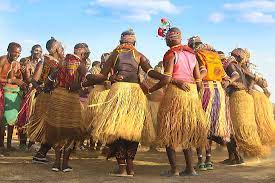This discussion focuses on the cultural heritage of Togo which is includes the culture and the heritage sites that can be found therein.
CULTURE OF TOGO
Togo’s culture reflects the influences of its 37 tribal ethnic groups, the largest and most influential of which are the Ewe, Mina, and Kabye. French is the official language of Togo, but many native African languages are spoken there as well. Despite the influence of Western religion, more than half of the people of Togo follow native animistic practices and beliefs.
Read: POLITICAL HISTORY OF TOGO
Ewe statuary is characterized by its famous statuettes which illustrate the worship of the twins, the ibéji. Sculptures and hunting trophies were used rather than the more ubiquitous African masks. The wood-carvers of Kloto are famous for their “chains of marriage”: two characters are connected by rings drawn from only one piece of wood.
The dyed fabric batiks of the artisanal center of Kloto represent stylized and colored scenes of ancient everyday life. The loincloths used in the ceremonies of the tisserands of Assahoun are famous. Works of the painter Sokey Edorh are inspired by the immense arid extents, swept by the harmattan, and where the laterite keeps the prints of the men and the animals. The plastics technician Paul Ahyi is internationally recognized today. He practices the “zota”, a kind of pyro engraving, and his monumental achievements decorate Lomé.
Festival
Togolese celebrate their traditional festival according their different ethnic groups.
Agbogbo Zã is celebrated in Notsè by Ewe ethnicity in memory of the walls and the history of Agbogbo. Dunenyo Zā is a traditional festival of Ewe people in south Togo. In August of every year, they celebrate their culture, Tradition and still thanking God for his peace. Ovazu is also a traditional festival in Akposs and Akebu
Music
Togolese people are still playing the traditional music around the country. Moba people, Akposso, Ewé are teaching the traditional rhythms to their children as heritage.
Dance
Each ethnic group has his traditional dances, with specific dances in different occasion. We have dance of funerals, storytelling, praise and worship. Some ethnic groups are choosing the danse of marriage. The are various dances across the 5 regions in Togo.
Food
Food in Daily Life. Togolese usually have two or three meals per day, each consisting largely of a starch product, such as cassava, maize, rice, yams, or plantains. A hot, spicy sauce is served with midday or evening meals, consisting of a protein—fish, goat, beans, or beef—and often rich in palm (red) oil or peanut paste. Fruits and vegetables, though readily available, are eaten more by the bourgeoisie. Traditional French staples, including baguettes, are mainstream in the cities.
Food Customs at Ceremonial Occasions. Food does not serve a significant ceremonial function, except perhaps in terms of animist rituals, when the sacrificed animals are prepared, cooked, and served. Beer, gin, and sodabi (distilled palm wine) are, however, essential. Among wealthy middle-class Togolese, the usual French three- or four-course meals are always served at functions.
HERITAGE SITE IN TOGO
Koutammakou, the Land of the Batammariba
Koutammakou, the Land of the Batammariba is a cultural heritage site located in northeastern Togo, near the border with Benin. The site is home to a traditional settlement of the Batammariba people, known for their unique architectural and cultural practices. The Batammariba people are particularly known for their construction of fortified mud houses known as “takienta”, which are designed to protect against invaders and are notable for their distinctive design and construction techniques. The Koutammakou landscape has been recognized as a Heritage Site since 2004 and is notable for its cultural and architectural significance. The site offers a glimpse into the traditional way of life of the Batammariba people and the ancient techniques they used to build their homes and communities.


